Make herb infused oils out of dried herbs from your own garden. These quality infused oils have a higher potency and are useful for salve making and balms.
The slow way to infuse olive oil and herbs
Learn how to make herbal infused oils using a cold extraction method, using sunlight and time to infuse the goodness of herbs into your quality oil. If you are in a hurry and need a first aid ointment right now, see my directions for making a fast oil infusion with herbs and my recipe for first aid ointment that you can begin today and have ready to use before nightfall.
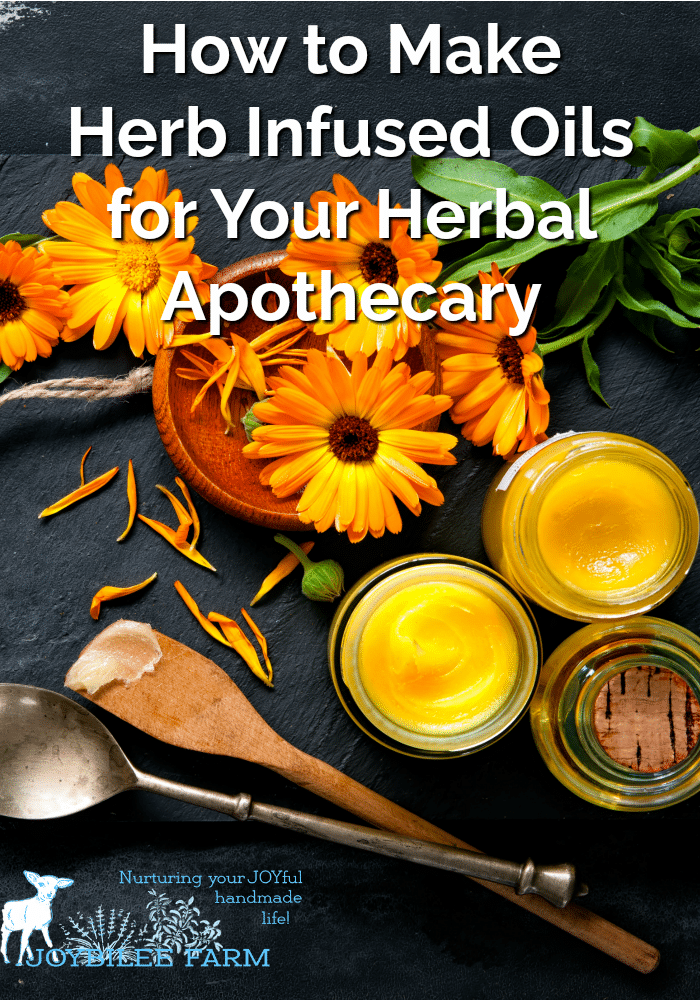
Almost any herb that you can make a tisane from can transform into infused oil. I prefer and infused olive oil or organic sweet almond oil for my recipes. You can easily turn these into a salve or ointment to use externally.
Herbs are versatile. They heal you on the inside and on the outside.
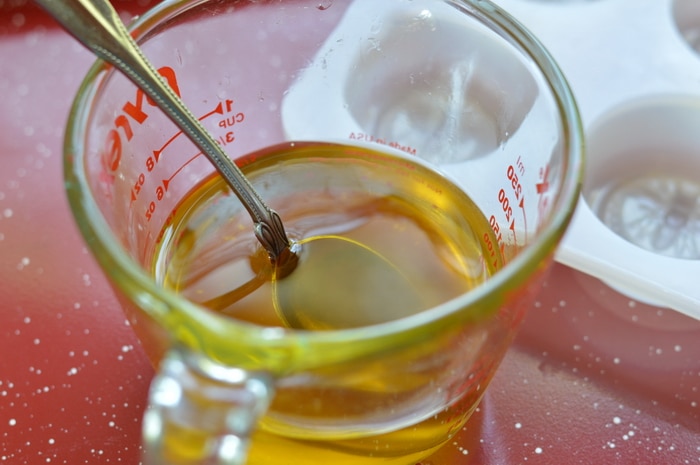
First, some caveats when infusing herbs in oil
Dried herbs are preferred when making an infused oil. The moisture from fresh herbs can cause mold and bacteria to grow in the oil, during the weeks when it’s macerating. The moisture can also cause the oil to go rancid. However, using dried herbs to make infused oil alleviates this danger.
Using fresh herbs:
Nevertheless, there are times you may want to use herbs fresh from the garden, and you can, provided that you dry any visible moisture from the plant material, and you allow it to wilt slightly before adding it to the oil.
To combat mold growth, you’ll want to fill the jars completely to the rim with oil and cap them tightly to exclude air. Mold can’t grow in the absence of air.
Check the jars at least once a week during the maceration time. If any sign of mold develops, discard the top layer of oil and plant material and pasteurize the remaining oil, immediately. Be sure to mark the jar, so that you don’t use this oil for an internal application. It can still be used for external applications once you have pasteurized it. Read this article from Food Safety Education for a good discussion on pasteurization.
When infusing fragile flower petals in oil, you may use them fresh, and slightly wilted. Dried flower petals will have lost some of their volatile oils in the drying process – especially if they are dried in a dehydrator rather than at room temperature. Since the volatile oils hold healing virtues, you want to capture them in your oil.
12 Herbs and their Skin Healing Properties
Check out this chart for the benefits of various garden herbs to your infused oil and topical salves
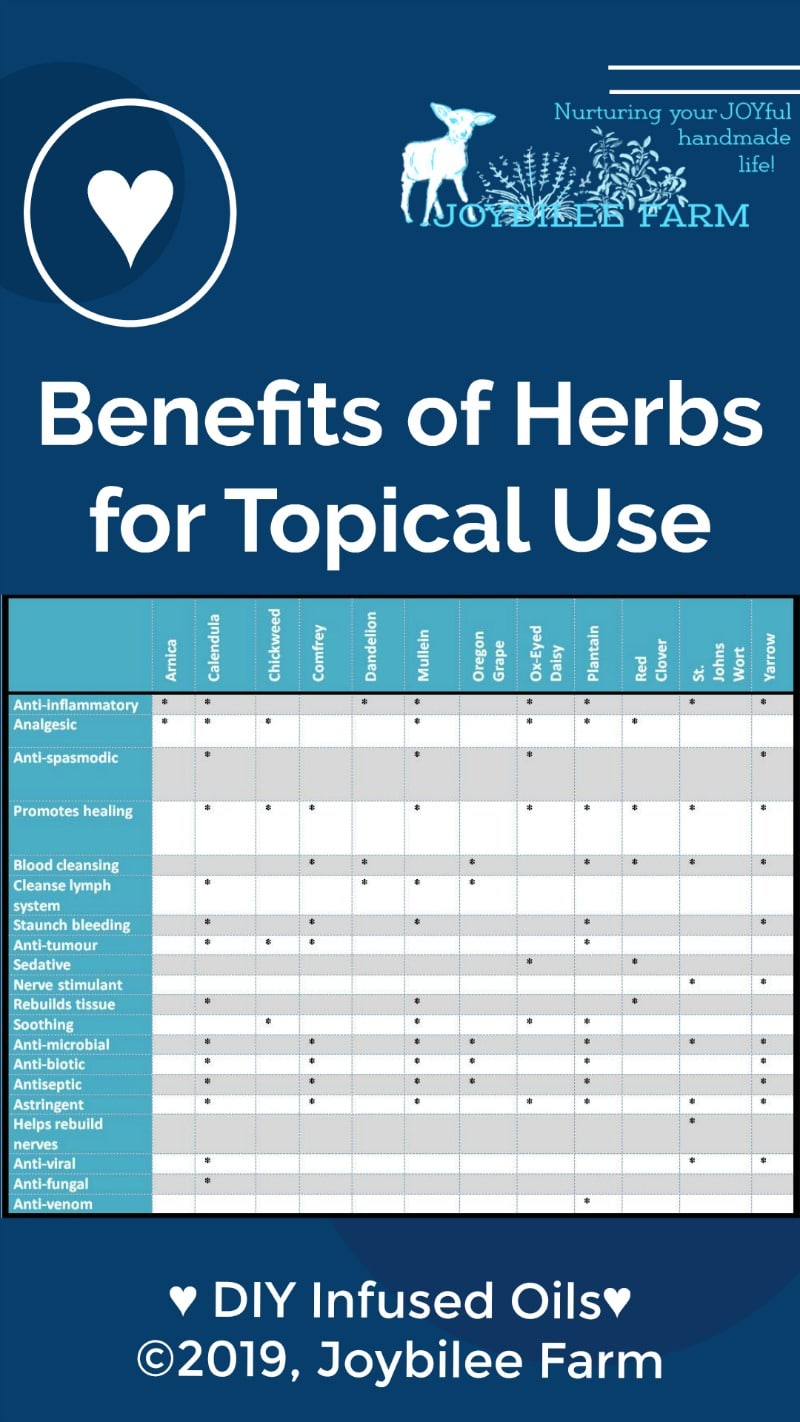
How to make a cold herbal infused oil:
Equipment you’ll need:
- Wide mouth pint Mason jar
- A tight-fitting lid
- Fine Sieve
Ingredients:
- 2 cups Organic Virgin Olive Oil or Organic Sweet Almond Oil or other cold-pressed oil of your choice
- 1 cup of Dried herbs of your choice or 1 1/2 cups of fresh and wilted herbs
- ¼ tsp. Natural Vitamin E or 4 capsules of Natural Vitamin E
Easy step by step guide to making infused oil from herbs
- Wash and sterilize all equipment.
- Put the herb of your choice into a dry glass jar that has a tight-fitting lid.
- Pour oil over herbs. If you are using fresh herbs, bring the level of the oil right to the rim.
- Use a knife to press down herbs and remove air pockets.
- Cap the jar tightly.
- Allow the herbs to macerate (become softened by soaking in a liquid) in a warm, sunny window.
- Tilt the jar daily to mix the herb and oil.
- After 4 to 6 weeks, strain the herb from the oil. You can leave it up to 8 weeks if you wish.
- Bottle in a blue or brown colored glass bottle.
- Add vitamin E, and gently shake to mix.
- Cap tightly and label.
- Store in a cool, dry place and protect from intense light.
Now you have an infused oil that is ready to use to make salves, ointments, healing and moisturizing balms, creams, and moisturizers. The possibilities are endless and it is always a great idea to have several versions of them in your DIY pantry for quick herbal medicine making.
If you used dried plant material, your infused oil can also be used in cooking or used raw in salad dressings, dips, and sauces.
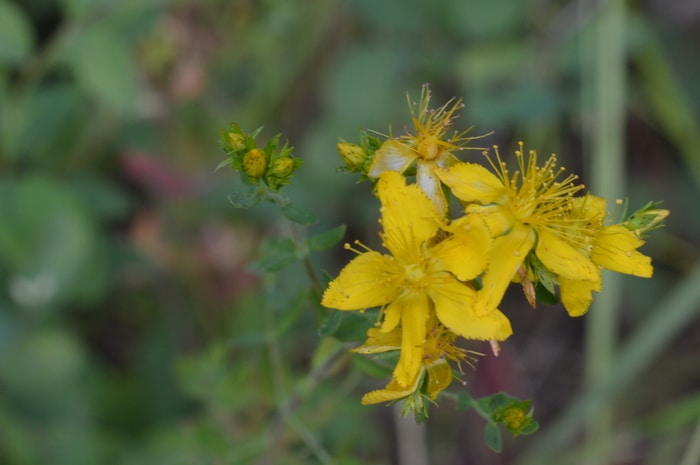
Some healing herbs to infuse in oil
St. John’s Wort flowers
St. John’s Wort blooms sometime between the end of June and the end of July, depending on your elevation and how far north you are. When it’s in bloom, gather the yellow flowers, as soon as the dew has dried on them, in the morning. You can harvest St Johns Wort by placing the flower stem between your index and middle finger and pulling your hand up the stalk, palm up. The flowers will fall into your hand.
Never take more than 1/3rd of the flowers from any plant, and always leave lots of flowers to feed the bees and to set seed for next year. Since St. John’s Wort is a perennial, the flowers will come back year after year, providing you with an annual harvest.
St. John’s Wort is a nervine, and anti-inflammatory. It relieves pain and is called for in cases of sciatica and other times when you have shooting pains. It is relaxing and analgesic.
Allow the flowers to wilt for several hours before macerating them in oil.

Calendula blossoms
Calendula is famous for its skin healing, and anti-inflammatory qualities. It is antimicrobial and anti-fungal. It is an important first-aid herb for abrasions, bruises, minor burns, sunburns, and inflammation. It can also be used internally for digestive inflammation and stomach pain — add a teaspoon full of calendula infused oil to salad dressing along with your other oils. Use it to make skin soothing first aid salve. Create a healing dog paw wax using calendula flowers infused in olive oil. Calendula is a mainstay in the herbal apothecary.
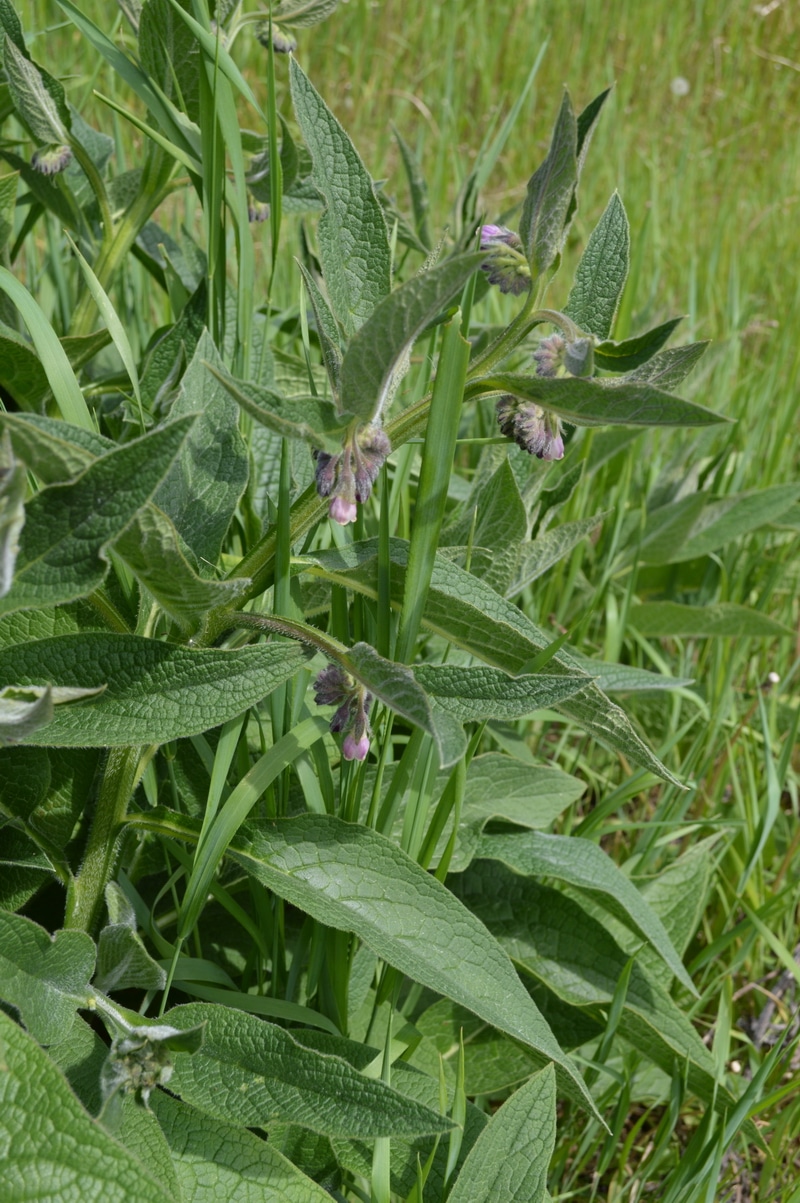
Comfrey Leaf
Comfrey is an excellent choice for your first aid ointment. It is anti-inflammatory, antipsoriatic, anti-mutagenic, and encourages the proliferation of new cells, in wounds. It encourages bone healing and should be your first choice in healing from a bone injury.
Safety: Although there is some concern that comfrey, taken internally can cause cancer, the evidence is inconclusive. Nonetheless, the external application of comfrey is considered safe. The suspect alkaloids in comfrey are absent from the dried leaf.
“The FDA advises against taking Comfrey internally, due to the presence of trace amounts of pyrrolizidine alkaloids (PA’s). In contrast, data published in the journal, Science, by noted biochemist Bruce Ames, PhD., of U.C. Berkley, would indicate that Comfrey taken internally is less toxic or carcinogenic than an equivalent amount of beer. It is probably wise NOT to make Comfrey, or beer, a significant part of your regular diet for an extended period of time.” – Philip Fritchey, Practical Herbalism, p.133.
For information on how to use comfrey for healing bone fractures see this post.
Oregon Grape Root
Antiseptic and antibiotic, Oregon grape root is used in first aid ointments. It has a great affinity to the skin and is the preferred berberine containing herb, where skin afflictions are the target. It is useful in the treatment of psoriasis, eczema, ulcerations, and zits.
Harvest the roots in the fall, by digging the external roots around a living plant, and leaving the larger, main roots intact. In this way, the patch can be left healthy and unharmed by your harvest.
Carefully clean the roots, cut into small pieces, and dry in a dehydrator on low heat 90 to 100F. Make your infused oil from the dried pieces of root, by pouring warmed oil over the root and leaving in a warm place. If your house is on the cool side, you can also use a slow cooker on warm to keep the oil warm for a week or two, while the roots infuse.
One of the beautiful things about using herbs that you grow yourself is that you can have a collection of herb infused oils, made when the herbs are prime for harvest. These will be ready to use whenever you need a special formula for treating a specific ailment, whether that is internal or external, acute or chronic.
Each bottle of infused oil is one more addition to your homestead apothecary – and one more step away from dependence and serfdom.
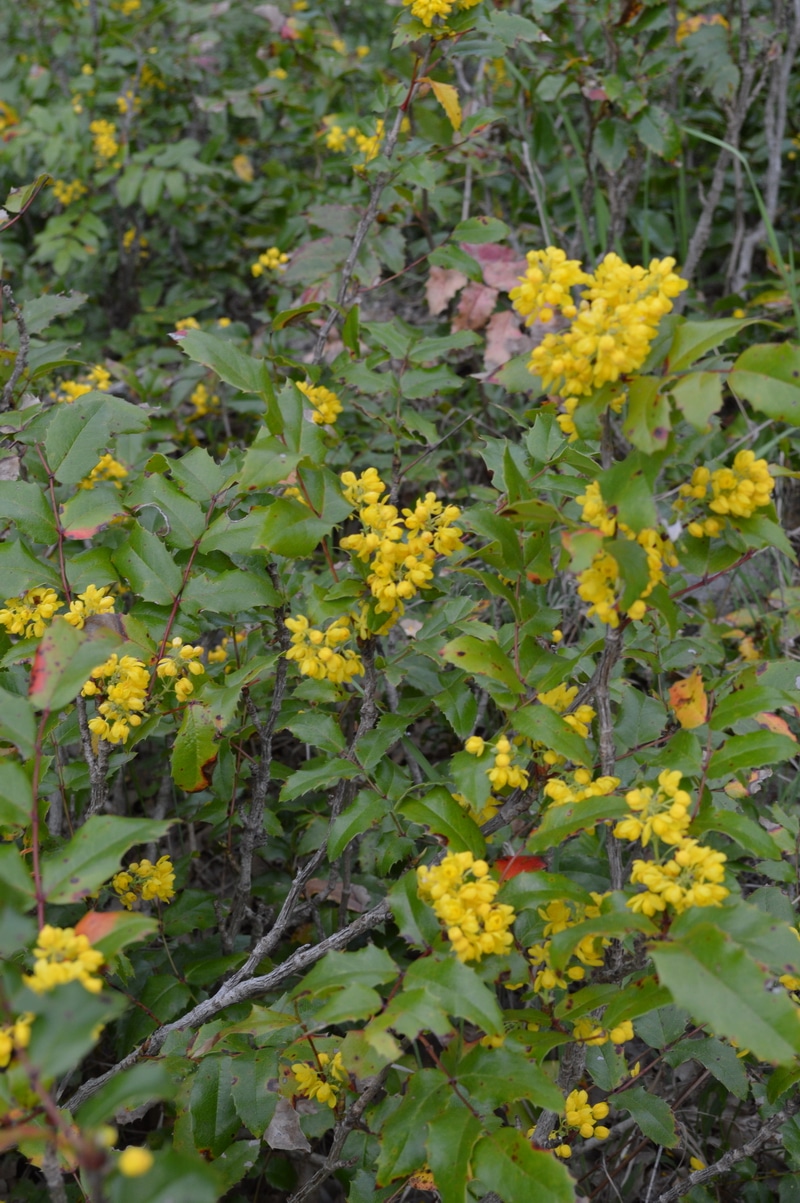
Basic Herbal First Aid Ointment
Yield: 4 x 2 ounce tins
- 2 tablespoons St. John’s Wort infused oil
- 2 tablespoons Calendula infused oil
- 2 tablespoons Comfrey infused oil
- 2 tablespoons Oregon Grape Root infused oil
- 3 tablespoons of cocoa butter (1 1/2 oz.)
- 1 tablespoon of beeswax (1/2 oz.)
- 25 drops of lavender essential oil
- 25 drops of tea tree essential oil
- 15 drops of myrrh essential oil
Instructions:
- Make a double boiler using a glass measuring cup.
- Add the infused oils, cocoa butter, and beeswax to the glass measuring cup. Place the pot over medium heat and heat just until the beeswax is melted. Stir to combine.
- Remove from heat. Allow the mixture to cool for 5 minutes.
- Add the essential oils.
- Stir briefly and pour into 4 x 2-ounce glass jars.
- Put on the lids while still warm.
Here are some other ideas for herbs that you may have growing in your garden or lawn that you can use to make infused oils and ointments for your medicine chest. Consider cooling dandelion salve as a replacement for Tiger Balm®, or DIY Arnica Salve to soothe the bruises and strains of your active lifestyle. Plantain is another herb with wonderful healing properties.
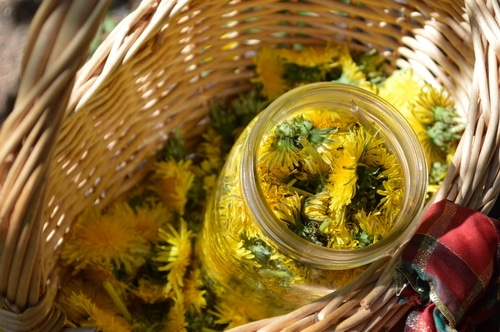
I am studying Herbalism at the The Herbal Academy. Their Introductory Herbal Course teaches you, in unit 5, how to make balms, butters, salves, and ointments to build your own herbal apothecary. It is a work at your own pace, online course, that will expand your knowledge and prepare the foundation for a lifelong study of herbs and herbal medicine.
The course is affordable, with a payment plan so you can start now, while the summer herbal harvest is at its peak. If you aren’t yet ready for formal study of herbs join my DIY Herbal membership group and learn herbs at your own pace.
References:
Philip Fritchey. Practical Herbalism, ordinary plants with Extraordinary Powers. (Warsaw, IN: Whitman Pub.) 2004.
David Hoffman. Medical Herbalism The Science and Practice of Herbal Medicine. (Rochester, Vt: Healing Arts Press) 2003.
The Intermediate Herbal Course. Herbal Academy of New England.
Updated May 2019



About 1/4 teaspoon is sufficient or 2 or 3 capsules.
Hi there! LOVE your DIY recipes! How much Vitamin E should be added into the calendula infused oil? Always afraid I’m going too add too much or too little. Thanks in advance beautiful!